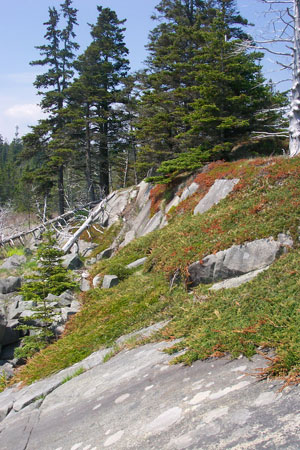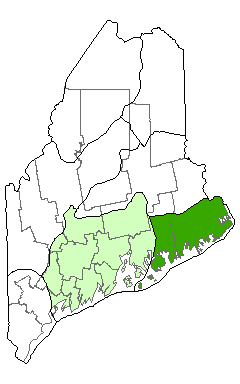DACF Home → Bureaus & Programs → Maine Natural Areas Program → Communities, Plants, and Animals → Natural Community Fact Sheets → Downeast Maritime Shrubland
Printer Friendly Fact Sheet - 840 KB pdf (Get a free copy of Adobe Acrobat Reader)
Downeast Maritime Shrubland
Scientific Name: Crowberry - Bayberry Headland; State Rank: S2

- Community Description
- Soil and Site Characteristics
- Diagnostics
- Similar Types
- Conservation, Wildlife and Management Considerations
- Distribution
- Characteristic Plants
- Associated Rare Plants
- Associated Rare Animals
- Examples on Conservation Lands You Can Visit
Community Description: Mat forming vegetation occurs on exposed maritime headlands. Most of the cover is dwarf heath shrubs and black crowberry growing only a few inches tall, punctuated by islands of taller shrubs such as bayberry or small spruce. Crowberry may carpet large areas. Creeping juniper or the more upright common juniper are often present. In the herb layer, three-toothed cinquefoil is characteristic. The bryoid layer is minor, but may feature reindeer lichens. Back to top.
Soil and Site Characteristics: Sites occur on extremely exposed, usually granitic headlands. Sites may contain pockets of peaty soil developing in rock hollows. Salt spray, fog, and wind are nearly constant elements. Back to top.
Diagnostics: Sites are characterized by the presence (and often dominance) of black crowberry, forming mats of vegetation with three-toothed cinquefoil and other species on exposed rocky coastal headlands. Back to top.
Similar Types: Rose Maritime Shrublands occur in similar settings, but are dominated by taller shrubs without a strong component of mat-forming shrubs. Open Headlands share many species and often co-occur with Downeast Maritime Shrublands, but the former are much more sparsely vegetated (vegetation often covers <25% of the rock surface overall), without extensive mats of dwarf shrub vegetation. Back to top.
Conservation, Wildlife and Management Considerations: Several known occurrences are on public or private conservation lands. While this protects them from conversion to other uses, it also increases the opportunity for foot traffic. Because the vegetation is so low to the ground, it is easily trampled and some sites have been degraded. The primary management consideration is to keep visitors on established trails as much as possible.
Rocky headland communities, especially those that occur on uninhabited islands, may provide nesting habitat for some pelagic bird species, such as the Atlantic puffin, razorbill, and Leach's storm petrel. Coastal breeders such as the common eider, American black duck, herring and great black-backed gulls, and Atlantic puffin may also use this habitat in appropriate settings. The crowberry blue butterfly is restricted to coastal heaths in east-coastal Maine. It is typically found in peatlands, where it uses black crowberry as a larval host plant, but could occur in this community as well. Back to top.
Distribution: Coastal Maine (often on islands) from Mount Desert Island eastward; extending into the Canadian Maritimes (Laurentian Mixed Forest Province). Landscape Pattern: Small Patch. Back to top.


Characteristic Plants: These plants are frequently found in this community type. Those with an asterisk are often diagnostic of this community.
- Dwarf Shrub
- Black crowberry*
- Creeping juniper
- Large cranberry*
- Lowbush blueberry*
- Mountain cranberry
- Swamp dewberry*
- Herb
- Bluebell
- Canada mayflower
- Red fescue
- Three-toothed cinquefoil
- Bryoid
- Reindeer lichen
- Crowberry blue
Examples on Conservation Lands You Can Visit
| Example | County |
|---|---|
| Cutler Public Lands | Washington Co. |
| Little Bois Bubert Island, Petit Manan National Wildlife Refuge | Washington Co. |
| Mistake Island Preserve | Washington Co. |
| Schoodic Peninsula, Acadia National Park | Hancock Co. |
| West Quoddy Head State Park | Washington Co. |